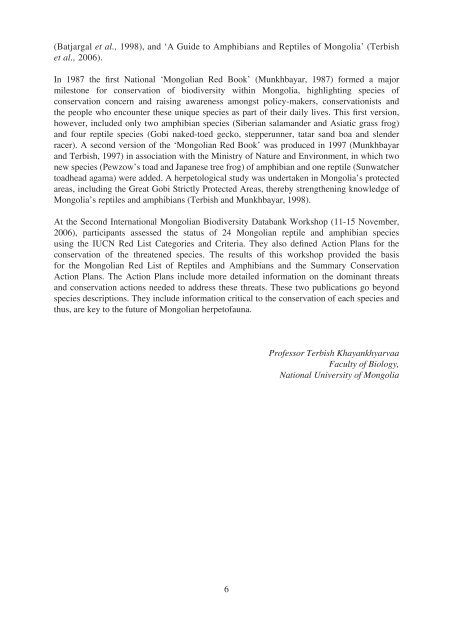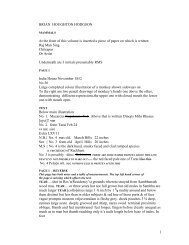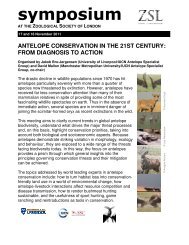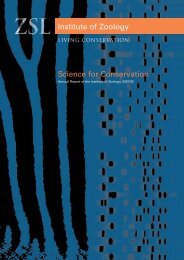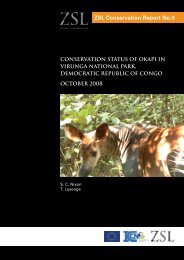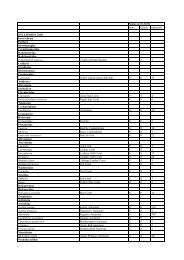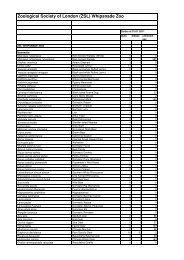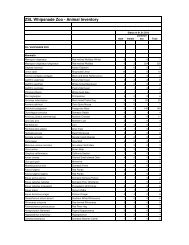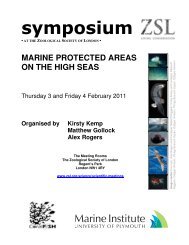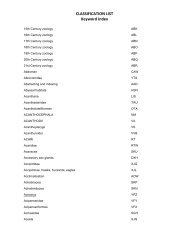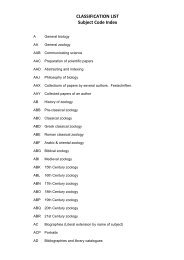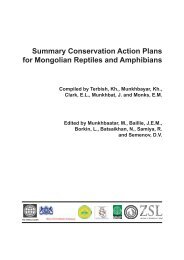Mongolian Red List of Reptiles and Amphibians - Web - Zoological ...
Mongolian Red List of Reptiles and Amphibians - Web - Zoological ...
Mongolian Red List of Reptiles and Amphibians - Web - Zoological ...
Create successful ePaper yourself
Turn your PDF publications into a flip-book with our unique Google optimized e-Paper software.
(Batjargal et al., 1998), <strong>and</strong> ‘A Guide to <strong>Amphibians</strong> <strong>and</strong> <strong>Reptiles</strong> <strong>of</strong> Mongolia’ (Terbish<br />
et al., 2006).<br />
In 1987 the fi rst National ‘<strong>Mongolian</strong> <strong>Red</strong> Book’ (Munkhbayar, 1987) formed a major<br />
milestone for conservation <strong>of</strong> biodiversity within Mongolia, highlighting species <strong>of</strong><br />
conservation concern <strong>and</strong> raising awareness amongst policy-makers, conservationists <strong>and</strong><br />
the people who encounter these unique species as part <strong>of</strong> their daily lives. This fi rst version,<br />
however, included only two amphibian species (Siberian salam<strong>and</strong>er <strong>and</strong> Asiatic grass frog)<br />
<strong>and</strong> four reptile species (Gobi naked-toed gecko, stepperunner, tatar s<strong>and</strong> boa <strong>and</strong> slender<br />
racer). A second version <strong>of</strong> the ‘<strong>Mongolian</strong> <strong>Red</strong> Book’ was produced in 1997 (Munkhbayar<br />
<strong>and</strong> Terbish, 1997) in association with the Ministry <strong>of</strong> Nature <strong>and</strong> Environment, in which two<br />
new species (Pewzow’s toad <strong>and</strong> Japanese tree frog) <strong>of</strong> amphibian <strong>and</strong> one reptile (Sunwatcher<br />
toadhead agama) were added. A herpetological study was undertaken in Mongolia’s protected<br />
areas, including the Great Gobi Strictly Protected Areas, thereby strengthening knowledge <strong>of</strong><br />
Mongolia’s reptiles <strong>and</strong> amphibians (Terbish <strong>and</strong> Munkhbayar, 1998).<br />
At the Second International <strong>Mongolian</strong> Biodiversity Databank Workshop (11-15 November,<br />
2006), participants assessed the status <strong>of</strong> 24 <strong>Mongolian</strong> reptile <strong>and</strong> amphibian species<br />
using the IUCN <strong>Red</strong> <strong>List</strong> Categories <strong>and</strong> Criteria. They also defi ned Action Plans for the<br />
conservation <strong>of</strong> the threatened species. The results <strong>of</strong> this workshop provided the basis<br />
for the <strong>Mongolian</strong> <strong>Red</strong> <strong>List</strong> <strong>of</strong> <strong>Reptiles</strong> <strong>and</strong> <strong>Amphibians</strong> <strong>and</strong> the Summary Conservation<br />
Action Plans. The Action Plans include more detailed information on the dominant threats<br />
<strong>and</strong> conservation actions needed to address these threats. These two publications go beyond<br />
species descriptions. They include information critical to the conservation <strong>of</strong> each species <strong>and</strong><br />
thus, are key to the future <strong>of</strong> <strong>Mongolian</strong> herpet<strong>of</strong>auna.<br />
6<br />
Pr<strong>of</strong>essor Terbish Khayankhyarvaa<br />
Faculty <strong>of</strong> Biology,<br />
National University <strong>of</strong> Mongolia


